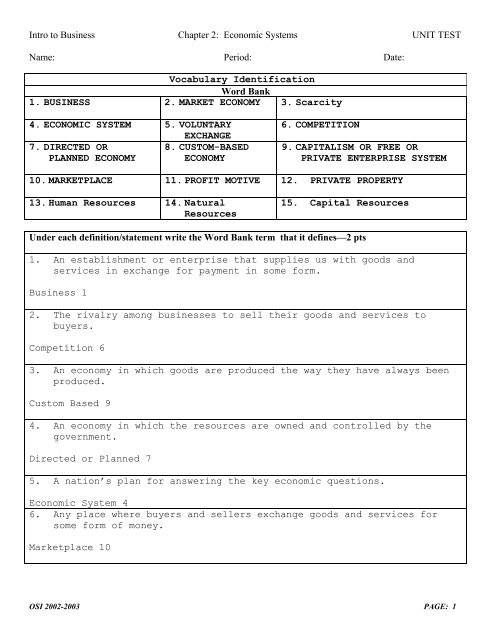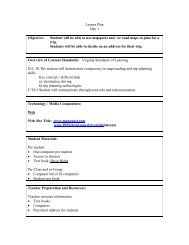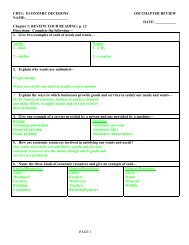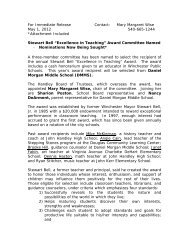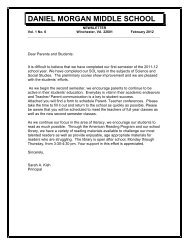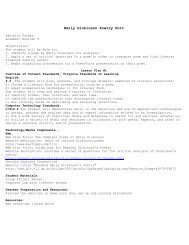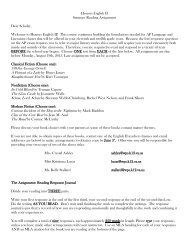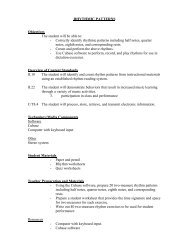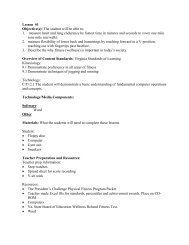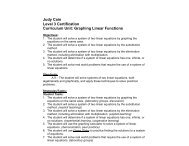Intro to Business Chapter 2: Economic Systems UNIT TEST Name ...
Intro to Business Chapter 2: Economic Systems UNIT TEST Name ...
Intro to Business Chapter 2: Economic Systems UNIT TEST Name ...
Create successful ePaper yourself
Turn your PDF publications into a flip-book with our unique Google optimized e-Paper software.
<strong>Intro</strong> <strong>to</strong> <strong>Business</strong> <strong>Chapter</strong> 2: <strong>Economic</strong> <strong>Systems</strong> <strong>UNIT</strong> <strong>TEST</strong><strong>Name</strong>: Period: Date:Vocabulary IdentificationWord Bank1. BUSINESS 2. MARKET ECONOMY 3. Scarcity4. ECONOMIC SYSTEM 5. VOLUNTARYEXCHANGE7. DIRECTED OR8. CUSTOM-BASEDPLANNED ECONOMYECONOMY6. COMPETITION9. CAPITALISM OR FREE ORPRIVATE ENTERPRISE SYSTEM10. MARKETPLACE 11. PROFIT MOTIVE 12. PRIVATE PROPERTY13. Human Resources 14. NaturalResources15. Capital ResourcesUnder each definition/statement write the Word Bank term that it defines—2 pts1. An establishment or enterprise that supplies us with goods andservices in exchange for payment in some form.<strong>Business</strong> 12. The rivalry among businesses <strong>to</strong> sell their goods and services <strong>to</strong>buyers.Competition 63. An economy in which goods are produced the way they have always beenproduced.Cus<strong>to</strong>m Based 94. An economy in which the resources are owned and controlled by thegovernment.Directed or Planned 75. A nation’s plan for answering the key economic questions.<strong>Economic</strong> System 46. Any place where buyers and sellers exchange goods and services forsome form of money.Marketplace 10OSI 2002-2003 PAGE: 1
<strong>Intro</strong> <strong>to</strong> <strong>Business</strong> <strong>Chapter</strong> 2: <strong>Economic</strong> <strong>Systems</strong> <strong>UNIT</strong> <strong>TEST</strong><strong>Name</strong>: Period: Date:True/False—2 pts eachDirections:Mark a in the corresponding True or False column <strong>to</strong> identify the statement as True or False:True False Statement:1. A place where buyers and sellers come <strong>to</strong>gether <strong>to</strong> trade goods, services, and resourcesis called a marketplace.2. Voluntary exchange is controlled by the government.3. Determining which of its citizens should benefit from the production of goods andservices is something each nation must decide.4. When the government or a business hires new employees, it is participating in themarketplace.5. The basic economic problem, meeting unlimited wants and needs with limited resourcesis referred <strong>to</strong> as scarcity.6. Scarcity is a problem that is faced by individuals, governments, and businesses.7. In a system of capitalism, the government decides what will be produced with theresources available.8. In a private enterprise system, you may start or invest in any business as long as it islegal <strong>to</strong> do so.9. The profit motive is designed <strong>to</strong> allow lazy owners <strong>to</strong> become rich.10. Freedom of choice is an important right included in a private enterprise system.11. The economic system in the United States is primarily considered <strong>to</strong> be a MarketEconomy.12. Most economies are composed of a mixture of characteristics from the three economicsystems: Market, Planned or Directed, and Cus<strong>to</strong>m based. This concept is described asa Mixed Economy.13. The economic system in the United States is pure capitalism with not governmentinvention or regulation involved.14. A place where buyers and sellers exchange goods and services for some form of moneyis called the marketplace.15. An establishment or enterprise that supplies goods and services in exchange for someform of payment is called a business.OSI 2002-2003 PAGE: 3
<strong>Intro</strong> <strong>to</strong> <strong>Business</strong> <strong>Chapter</strong> 2: <strong>Economic</strong> <strong>Systems</strong> <strong>UNIT</strong> <strong>TEST</strong><strong>Name</strong>: Period: Date:Multiple Choice—2 pts eachDirections:Write the letter of the answer that best completes each statement in the corresponding answer columnAnswer Statement:ColumnA6. Members of a family might not be able <strong>to</strong> afford the things they want because aneconomic fac<strong>to</strong>r called:a) the basic economic problem—scarcityb) the family economic problemc) multiple greedd) human desiresBABD7. What step is defining the problem in the decision making process?a) secondb) firstc) lastd) third8. Which of the following describes a situation in which scarcity can be a problem?a) a city wants <strong>to</strong> give fire fighters a large pay increaseb) a business wants <strong>to</strong> enlarge its plantc) a family wants <strong>to</strong> extend its vacationd) all of the above9. Things you can see and <strong>to</strong>uch are called:a) servicesb) goodsc) scarcityd) none of the above10. Examples of raw materials include:a) oilb) waterc) diamondsd) all of the aboveOSI 2002-2003 PAGE: 5
<strong>Intro</strong> <strong>to</strong> <strong>Business</strong> <strong>Chapter</strong> 2: <strong>Economic</strong> <strong>Systems</strong> <strong>UNIT</strong> <strong>TEST</strong><strong>Name</strong>: Period: Date:Identification: 5 ptsThe three questions every economic system must answer in its efforts <strong>to</strong> solve thebasic economic problem (Scarcity) are: Write your answers below???1—WHAT TO PRODUCE2—HOW TO PRODUCE3—FOR WHOM TO PRODUCEIdentification: 5 ptsWhat are the FIVE CHARACTERISTICS of a market economy:1—Private enterprise2—Private property3—Profit4—Competition5—Freedom of choice10 point Bonus QuestionLIST THE SIX STEPS IN THE DECISION-MAKING PROCESS:1. Identify the Problem2. Identify the choices3. Evaluate the advantages and disadvantages of each choice4. Choose5. Act6. Evaluate the outcomeOSI 2002-2003 PAGE: 6


